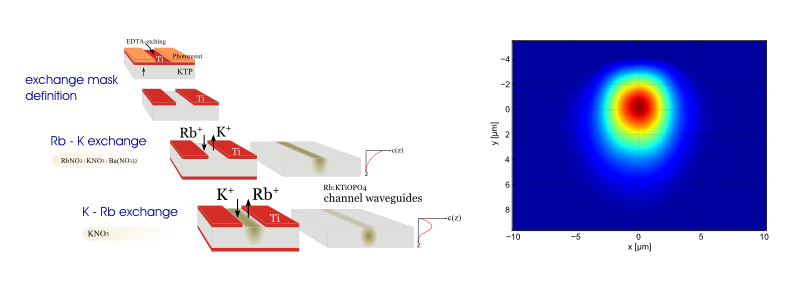Waveguide fabrication in KTP
Potassium titanyl phosphate (KTP) is another interesting nonlinear optical material for integrated quantum optics. Waveguides of good optical quality can be fabricated by Rb-K-ion exchange [1]. They are guiding in both, TE- and TM polarization and, therefore, allow any kind of quasi-phase matching (type 0 - II). Moreover, its dispersive properties are very interesting for ultrafast continuous variable quantum optics. We are currently setting up the technology of ion-exchanged and periodically poled Rb:KTP (Rb:PPKTP-) waveguides.
1.1. Rb-exchanged waveguides in flux-grown KTP (fKTP)
Similar to the proton-exchanged waveguides in CLN an exchange mask is photolithographically defined on the KTP-substrate. The Rb-ion exchange is performed in a Ba(NO3)2 buffered RbNO3-melt at about 350°C. The duration of the exchange depends on whether buried or non-buried channel waveguides are fabricated.
1.2. Buried Rb-exchanged waveguides in flux-grown KTP (fKTP)
Similar to RPE-waveguides in CLN Rb-exchanged waveguides can be buried using a reversed ion exchange in a K-rich melt. By immersing the as-Rb-exchanged waveguides into a KNO3 melt about 350°C the surface near Rb-profile is depleted by outdiffusion of Rb and indiffusion of K leading to a buried refractive index profile. For such waveguides losses down to 0.2 dB/cm have already been achieved at telecom wavelengths. Fig. 1 (right) shows the near field intensity distribution of a TM-mode at 1530 nm of such a buried 5.5 μm wide channel in Z-cut X-propagation fKTP.
References
- Fabrication and characterization of optical waveguides in KTiOPO4
John D. Bierlein, August Ferretti, Lothar H. Brixner, and William Y. Hsu
Applied Physics Letters, 50(18):1216, 1987

